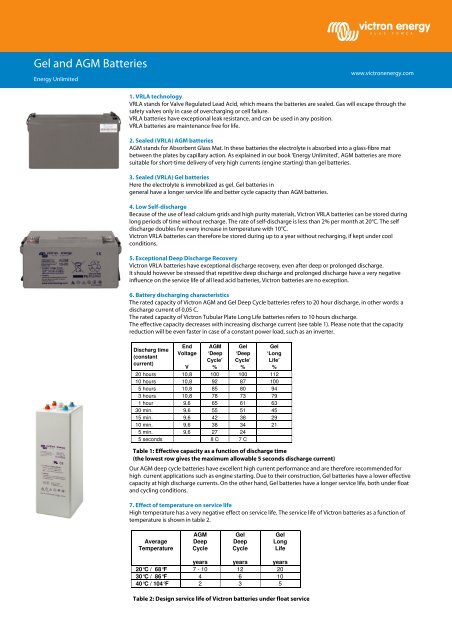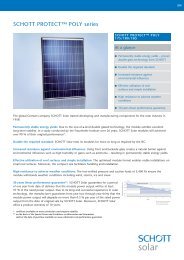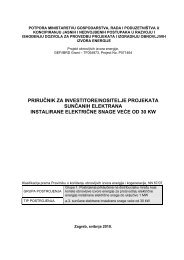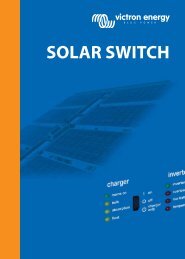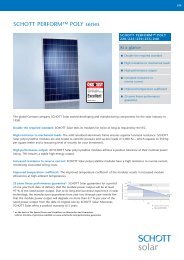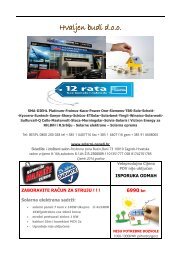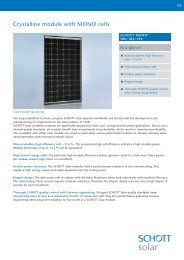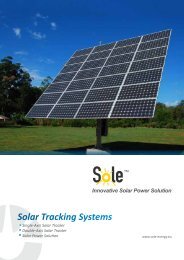Gel and AGM Batteries - Solarni paneli | Sole
Gel and AGM Batteries - Solarni paneli | Sole
Gel and AGM Batteries - Solarni paneli | Sole
You also want an ePaper? Increase the reach of your titles
YUMPU automatically turns print PDFs into web optimized ePapers that Google loves.
<strong>Gel</strong> <strong>and</strong> <strong>AGM</strong> <strong>Batteries</strong><br />
Energy Unlimited<br />
www.victronenergy.com<br />
1. VRLA technology<br />
VRLA st<strong>and</strong>s for Valve Regulated Lead Acid, which means the batteries are sealed. Gas will escape through the<br />
safety valves only in case of overcharging or cell failure.<br />
VRLA batteries have exceptional leak resistance, <strong>and</strong> can be used in any position.<br />
VRLA batteries are maintenance free for life.<br />
2. Sealed (VRLA) <strong>AGM</strong> batteries<br />
<strong>AGM</strong> st<strong>and</strong>s for Absorbent Glass Mat. In these batteries the electrolyte is absorbed into a glass-fibre mat<br />
between the plates by capillary action. As explained in our book ‘Energy Unlimited’, <strong>AGM</strong> batteries are more<br />
suitable for short-time delivery of very high currents (engine starting) than gel batteries.<br />
3. Sealed (VRLA) <strong>Gel</strong> batteries<br />
Here the electrolyte is immobilized as gel. <strong>Gel</strong> batteries in<br />
general have a longer service life <strong>and</strong> better cycle capacity than <strong>AGM</strong> batteries.<br />
4. Low Self-discharge<br />
Because of the use of lead calcium grids <strong>and</strong> high purity materials, Victron VRLA batteries can be stored during<br />
long periods of time without recharge. The rate of self-discharge is less than 2% per month at 20°C. The self<br />
discharge doubles for every increase in temperature with 10°C.<br />
Victron VRLA batteries can therefore be stored during up to a year without recharging, if kept under cool<br />
conditions.<br />
5. Exceptional Deep Discharge Recovery<br />
Victron VRLA batteries have exceptional discharge recovery, even after deep or prolonged discharge.<br />
It should however be stressed that repetitive deep discharge <strong>and</strong> prolonged discharge have a very negative<br />
influence on the service life of all lead acid batteries, Victron batteries are no exception.<br />
6. Battery discharging characteristics<br />
The rated capacity of Victron <strong>AGM</strong> <strong>and</strong> <strong>Gel</strong> Deep Cycle batteries refers to 20 hour discharge, in other words: a<br />
discharge current of 0,05 C.<br />
The rated capacity of Victron Tubular Plate Long Life batteries refers to 10 hours discharge.<br />
The effective capacity decreases with increasing discharge current (see table 1). Please note that the capacity<br />
reduction will be even faster in case of a constant power load, such as an inverter.<br />
Discharg time<br />
(constant<br />
current)<br />
End<br />
Voltage<br />
V<br />
<strong>AGM</strong><br />
‘Deep<br />
Cycle’<br />
%<br />
<strong>Gel</strong><br />
‘Deep<br />
Cycle’<br />
%<br />
<strong>Gel</strong><br />
‘Long<br />
Life’<br />
%<br />
20 hours 10,8 100 100 112<br />
10 hours 10,8 92 87 100<br />
5 hours 10,8 85 80 94<br />
3 hours 10,8 78 73 79<br />
1 hour 9,6 65 61 63<br />
30 min. 9,6 55 51 45<br />
15 min. 9,6 42 38 29<br />
10 min. 9,6 38 34 21<br />
5 min. 9,6 27 24<br />
5 seconds 8 C 7 C<br />
Table 1: Effective capacity as a function of discharge time<br />
(the lowest row gives the maximum allowable 5 seconds discharge current)<br />
Our <strong>AGM</strong> deep cycle batteries have excellent high current performance <strong>and</strong> are therefore recommended for<br />
high current applications such as engine starting. Due to their construction, <strong>Gel</strong> batteries have a lower effective<br />
capacity at high discharge currents. On the other h<strong>and</strong>, <strong>Gel</strong> batteries have a longer service life, both under float<br />
<strong>and</strong> cycling conditions.<br />
7. Effect of temperature on service life<br />
High temperature has a very negative effect on service life. The service life of Victron batteries as a function of<br />
temperature is shown in table 2.<br />
Average<br />
Temperature<br />
<strong>AGM</strong><br />
Deep<br />
Cycle<br />
<strong>Gel</strong><br />
Deep<br />
Cycle<br />
<strong>Gel</strong><br />
Long<br />
Life<br />
years years years<br />
20°C / 68°F 7 - 10 12 20<br />
30°C / 86°F 4 6 10<br />
40°C / 104°F 2 3 5<br />
Table 2: Design service life of Victron batteries under float service
8. Effect of temperature on capacity<br />
As is shown by the graph below, capacity reduces sharply at low temperatures.<br />
www.victronenergy.com<br />
9. Cycle life of Victron batteries<br />
<strong>Batteries</strong> age due to discharging <strong>and</strong> recharging. The number of cycles depends on the depth of discharge, as is<br />
shown in figure 2.<br />
<strong>AGM</strong> Deep Cycle <strong>Gel</strong> Deep Cycle <strong>Gel</strong> Long Life<br />
10. Battery charging in case of cycle use: the 3-step charge characteristic<br />
The most common charge curve used to charge VRLA batteries in case of cyclic use is the 3-step charge<br />
characteristic, whereby a constant current phase (the bulk phase) is followed by two constant voltage phases<br />
(absorption <strong>and</strong> float), see fig. 3.<br />
Charge voltage<br />
Fig. 1: Effect of temperature on capacity<br />
Fig. 2: Cycle life<br />
Depth of discharge<br />
Fig. 3: Three step charge curve<br />
During the absorption phase the charge voltage is kept at a relatively high level in order to fully recharge the<br />
battery within reasonable time. The third <strong>and</strong> last phase is the float phase: the voltage is lowered to st<strong>and</strong>by<br />
level, sufficient to compensate for self discharge.<br />
Charge current
www.victronenergy.com<br />
Disadvantages of the traditional 3-step charge characteristic:<br />
• During the bulk phase the current is kept at a constant <strong>and</strong> often high level, even after the gassing<br />
voltage (14,34 V for a 12 V battery) has been exceeded. This can lead to excessive gas pressure in the<br />
battery. Some gas will escape trough the safety valves, reducing service life.<br />
• Thereafter the absorption voltage is applied during a fixed period of time, irrespective of how deep<br />
the battery has been discharged previously. A full absorption period after a shallow discharge will<br />
overcharge the battery, again reducing service life. (a. o. due to accelerated corrosion of the positive<br />
plates)<br />
• Research has shown that battery life can be increased by decreasing float voltage to an even lower<br />
level when the battery is not in use.<br />
11. Battery charging: longer battery life with Victron 4-step adaptive charging<br />
Victron developed the adaptive charge characteristic. The 4-step adaptive chare curve is the result of years of<br />
research <strong>and</strong> testing.<br />
The Victron adaptive charge curve solves the 3 main problems of the 3 step curve:<br />
• Battery Safe mode<br />
In order to prevent excessive gassing, Victron has invented the ‘Battery Safe Mode’. The battery Safe<br />
Mode will limit the rate of voltage increase once the gassing voltage has been reached. Research has<br />
shown that this will reduce internal gassing to a safe level.<br />
• Variable absorption time<br />
Based on the duration of the bulk stage, the charger calculates how long the absorption time should<br />
be in order to fully charge the battery. If the bulk time is short, this means the battery was already<br />
charged <strong>and</strong> the resulting absorption time will also be short, whereas a longer bulk time will also<br />
result in a longer absorption time.<br />
• Storage mode<br />
After completion of the absorption period the battery should be fully charged, <strong>and</strong> the voltage is<br />
lowered to the float or st<strong>and</strong>by level. If no discharge occurs during the next 24 hours, the voltage is<br />
reduced even further <strong>and</strong> the battery goes into storage mode. The lower storage voltage reduces<br />
corrosion of the positive plates.<br />
Once every week the charge voltage is increased to the absorption level for a short period to<br />
compensate for self discharge (Battery Refresh mode).<br />
12. Battery charging in case of st<strong>and</strong>by use: constant voltage float charging<br />
When a battery is not frequently deeply discharged, a 2-step charge curve can be used. During the first phase<br />
the battery is charged with a limited current (the bulk phase). Once a preset voltage has been reached the<br />
battery is kept at that voltage (the float phase).<br />
This charge method is used for starter batteries in vehicles, <strong>and</strong> in uninterruptible power supplies (UPS).<br />
Fig. 4: Four-step adaptive charge curve<br />
13. Optimum charge voltage of Victron VRLA batteries<br />
The recommended charge voltage settings for a 12 V battery are shown in table 3.<br />
14. Effect of temperature on charging voltage<br />
The charge voltage should be reduced with increased temperature. Temperature compensation is required when the<br />
temperature of the battery is expected to be less than 10°C / 50°F or more than 30°C / 85°F during long periods of time.<br />
The recommended temperature compensation for Victron VRLA batteries is -4 mV / Cell (-24 mV /°C for a 12 V battery).<br />
The centre point for temperature compensation is 20°C / 70°F.
Victron Energy B.V. | De Paal 35 | 1351 JG Almere | The Netherl<strong>and</strong>s<br />
General phone: +31 (0)36 535 97 00 | Fax: +31 (0)36 535 97 40<br />
E-mail: sales@victronenergy.com | www.victronenergy.com<br />
www.victronenergy.com<br />
15. Charge current<br />
The charge current should preferably not exceed 0,2 C (20 A for a 100 Ah battery).The temperature of a battery will increase by more than 10°C if the charge<br />
current exceeds 0,2 C. Therefore temperature compensation is required if the charge current exceeds 0,2 C<br />
Float<br />
Cycle service<br />
Cycle service<br />
service<br />
Victron <strong>AGM</strong> “Deep Cycle”<br />
Normal<br />
Fastest recharge<br />
Absorbtion 14,2 - 14,6 14,6 - 14,9<br />
Float 13,5 - 13,8 13,5 - 13,8 13,5 - 13,8<br />
Storage 13,2 - 13,5 13,2 - 13,5 13,2 - 13,5<br />
Victron <strong>Gel</strong> “Deep Cycle”<br />
Absorbtion 14,1 - 14,4<br />
Float 13,5 - 13,8 13,5 - 13,8<br />
Storage 13,2 - 13,5 13,2 - 13,5<br />
Victron <strong>Gel</strong> “Long Life”<br />
Absorbtion 14,0 - 14,2<br />
Float 13,5 - 13,8 13,5 - 13,8<br />
Storage 13,2 - 13,5 13,2 - 13,5<br />
Table 3: Recommended charge voltage<br />
12 Volt Deep Cycle <strong>AGM</strong><br />
General Specification<br />
l x w x h Weight CCA RES CAP Technology: flat plate <strong>AGM</strong><br />
Article number Ah V mm<br />
kg @0°F @80°F Terminals: copper<br />
BAT406225080 240 6 320x176x247 31 1500 480 Rated capacity: 20 hr discharge at 25°C<br />
BAT212070080<br />
BAT212120080<br />
BAT212200080<br />
BAT412350080<br />
8<br />
14<br />
22<br />
38<br />
12<br />
12<br />
12<br />
12<br />
151x65x101<br />
151x98x101<br />
181x77x167<br />
197x165x170<br />
2,5<br />
4,1<br />
5,8<br />
12,5<br />
Float design life: 7-10 years at 20 °C<br />
Cycle design life:<br />
200 cycles at 100% discharge*<br />
400 cycles at 50% discharge<br />
900 cycles at 30% discharge<br />
BAT412550080 60 12 229x138x227 20 450 90<br />
BAT412600080 66 12 258x166x235 24 520 100<br />
BAT412800080 90 12 350x167x183 27 600 145<br />
BAT412101080 110 12 330x171x220 32 800 190<br />
BAT412121080 130 12 410x176x227 38 1000 230<br />
BAT412151080 165 12 485x172x240 47 1200 320<br />
BAT412201080 220 12 522x238x240 65 1400 440<br />
12 Volt Deep Cycle GEL<br />
General Specification<br />
l x w x h Weight CCA RES CAP Technology: flat plate GEL<br />
Article number Ah V mm<br />
kg @0°F @80°F Terminals: copper<br />
BAT412550100 60 12 229x138x227 20 300 80 Rated capacity: 20 hr discharge at 25 °C<br />
BAT412600100<br />
BAT412800100<br />
BAT412101100<br />
BAT412121100<br />
66<br />
90<br />
110<br />
130<br />
12<br />
12<br />
12<br />
12<br />
258x166x235<br />
350x167x183<br />
330x171x220<br />
410x176x227<br />
24<br />
26<br />
33<br />
38<br />
360<br />
420<br />
550<br />
700<br />
90<br />
130<br />
180<br />
230<br />
Float design life: 12 years at 20 °C<br />
Cycle design life:<br />
300 cycles at 100% discharge *<br />
600 cycles at 50% discharge<br />
1300 cycles at 30% discharge<br />
BAT412151100 165 12 485x172x240 48 850 320<br />
BAT412201100 220 12 522x238x240 66 1100 440<br />
2 Volt Long Life GEL General Specification<br />
l x b x h Weight Technology: tubular plate GEL<br />
Article number Ah V mm<br />
kg Terminals: copper<br />
BAT702601260 600 2 149x208x710 48 Rated capacity: 10 hr discharge at 25 °C<br />
BAT702801260<br />
BAT702102260<br />
BAT702122260<br />
BAT702152260<br />
800<br />
1000<br />
1200<br />
1500<br />
2<br />
2<br />
2<br />
2<br />
215x193x710<br />
215x235x710<br />
215x277x710<br />
215x277x855<br />
68<br />
82<br />
94<br />
120<br />
Float design life: 20 years at 20 °C<br />
Cycle design life:<br />
1200 cycles at 100% discharge *<br />
1200 cycles at 50% discharge<br />
2400 cycles at 30% discharge<br />
BAT702202260 2000 2 215x400x815 160<br />
BAT702252260 2500 2 215x490x815 200<br />
BAT702302260 3000 2 215x580x815 240<br />
Other capacities <strong>and</strong> terminal types: at request<br />
* End of discharge voltage: 10,8 V for a 12 V battery


